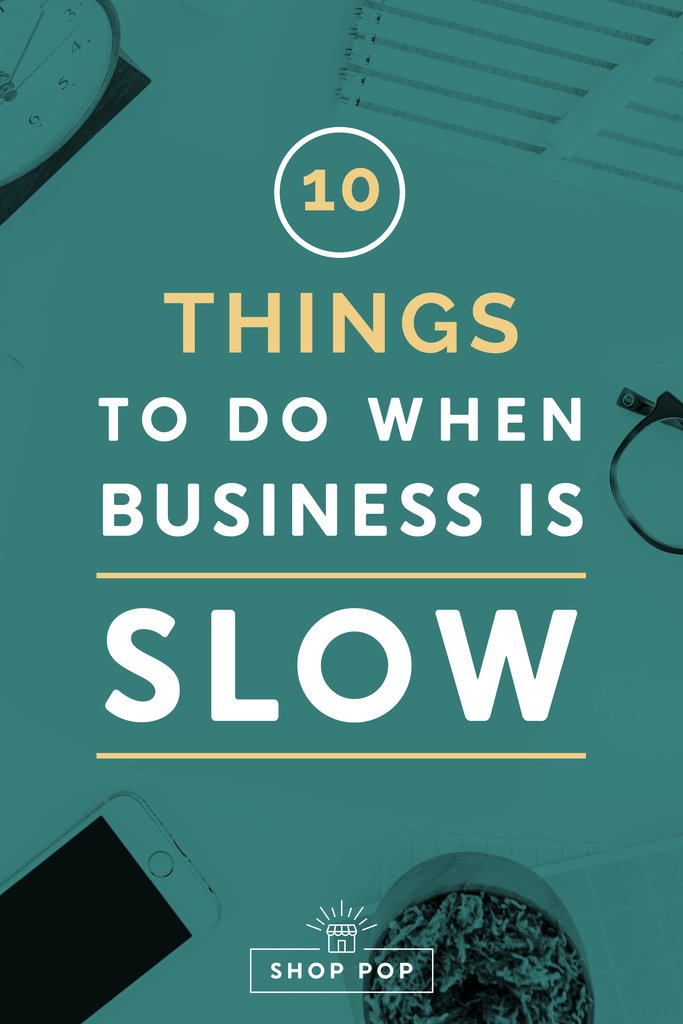Slow seasons for shop owners are inevitable. Sales spikes in December and May can be followed by slow Januarys and Julys. So what can you do in a slow season to boost your sales?
Here are ten strategic things to do when e-commerce sales are slow.

1. Plan your marketing calendar
Slow seasons are the perfect time to plan future promotions, so when business picks up, you’re ready to win more sales than ever.
A promotion is any: product launch, sale, feature, collaboration, contest, or event you do in order to build excitement for your brand.
I recommend planning these out three-six months in advance, so each promotion is well executed.
Once you have your big picture promotions calendared, plan the content you will create to support it.
Content is any: email, printed material, blog, social post, video, pin, or communication you create in order to support your promotion.
At this stage, you don’t need to actually create your content, but having a gameplan for what you will create and when will help you when a busy season arrives.
2. Learn a Profit-Boosting Skill
Has “Figure out Pinterest” or “Get good at email marketing” been on your to-do list for a while? When we’re busy, these important (but not urgent) tasks can get pushed to the bottom of the list.
So in a slow season, take advantage of the extra margin to finally invest in the skills you need to grow your business.
Looking for a place to start? Sites like Skillshare and LinkedIn Learning have classes on a variety of topics. And if you’re looking to sharpen your email game, our Mailbox Money Session is a power-hour consult to help you craft your email strategy.
3. Set up Email Automations
Email automations are emails that send automatically when someone takes a certain action or a certain requirement is met.
Automations like a welcome sequence, birthday reward, or abandoned cart email are often the most highly opened (and profitable) emails businesses send because they are relevant and timely.
And the best part is, you only have to set them up once and monitor the results!
So when time is on your side, set these high-powered emails up to send, so you can start marketing on autopilot.
For more, check out this post with 8 email automations every e-commerce shop should try.
4. Host an Event
An event is a great way to create excitement around your brand. If you have a retail location consider hosting a sidewalk sale or “sip and shop” event. If you don’t have a brick-and-mortar store, ask a retailer if you can host a trunk show at their location or team up with other small brands for a multi-business shopping event.
Your event doesn’t have to be elaborate to draw a crowd. Customers are looking for a “reason” to shop, and a fun event gives them an extra push to grab a gal pal and have some fun!
5. Work on SEO
SEO (Search Engine Optimization) is the practice of using keywords (among other strategies) to make your website rank more highly in Google searches.
This a large and technical topic, but any shop owner can learn the basics to improve their search ranking. To get started, I recommend listening to these two episodes from Jenna Kutcher’s Goal Digger podcast:
6. Form a Collaboration with a Complimentary Brand
A collaboration can re-energize your product mix and also introduce your brand to new audiences.
To start, think about other businesses that offer complementary products that you can offer alongside your product.
For example, to promote Mother’s Day Sales, nail polish company, Olive & June, created a gift set with Farmgirl Flowers.

You can also pursue collaborations with businesses to make a co-branded product. For instance, if you make candles you could work with a local potter to develop a custom container for a limited-edition product.
7. Pitch Media Outlets
PR is a free way to get brand exposure through media. Traditional PR involves pitching newspapers, television stations, and magazines to get placed in a specific story like: “Best Gifts for Eco-Conscious Moms.”
While these placements are still valuable, today you can also consider pitching your story idea to bloggers and podcasters, too!
The key is to make sure you’re only pitching outlets your target audience is engaged with. And do your research before sending a pitch!
For more information on how to craft the perfect pitch, I recommend the book “Recipe for Press” by Amy Flurry.
8. Update Your Website
When’s the last time you gave your website a good once-over? A slow season is a great time to tweak and refine so it’s primed for peak sales seasons.
Try things like: swapping images, refreshing copy, updating your about page, relocating buttons, or redesigning your home page.
Then, ask a friend who is not familiar with your site to log on.
Watch them as they surf your site to see: where they go, where they get stuck, and what they miss entirely. Use what you observe to further optimize your site.
9. Refresh your Product Descriptions
For many shop owners, product descriptions are a frustrating final barrier to get your hard-worked product to market. And often, they’ll just quickly pen something and press publish.
In your slower season, take the opportunity and go back to improve and refresh your product descriptions.
A good product description answers key questions about size, color, materials, and use cases. Giving detailed information for each one of these points can be the difference between a won or lost sale.
10. Survey Your Customers
Learn how you can serve your current customers in the season to come through a thoughtful survey. You can use Google Forms, Typeform, or Survey Monkey to create your questionnaire. For the best results, make sure your survey takes less than five minutes to complete.
Once you’ve created your survey, send it to your email list and promote it on social media. You can even offer participants a small incentive or coupon to take the survey to increase your response rate.
Next Steps
Remember, slow seasons are unavoidable, but they can still be “profitable.” Next time business feels sluggish, try one of these ten strategies to plant good seeds for the harvest ahead.
+ show Comments
- Hide Comments
add a comment